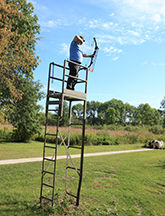Natural Features
The Iroquois State Wildlife Area exhibits some of the finest and most extensive prairie marsh and sand dune vegetation remaining in Illinois. The occurrence of this vegetation is regulated by soil characteristics and moisture. Dry sand ridges are dominated by black oak forest. Lower lying areas range from dry prairie to marsh, depending on soil moisture. Dominant grasses on dry prairie areas are little bluestem and switch grass. Grasses such as big bluestem, Indian grass, little bluestem and switch grass are dominant on mesic (intermediate between wet and dry) prairie. Areas of wet prairie are indicated by bluejoint grass, cord grass and sedges. Several boggy areas contain plants seldom encountered elsewhere in Illinois, including blueberry, huckleberry, hardhack, march marigold, colic root, sundew (a carnivorous plant) and primrose violet.
Aside from supporting huntable populations of deer and upland game, Iroquois State Wildlife Area is inhabited by numerous, interesting non-game birds and mammals. Wet prairies and marshes provide preferred habitat for birds such as herons, bitterns, rails, snipe and marsh hawks. During migration, marshes are visited by numerous species of waterfowl and the rare sandhill crane. Mammals utilizing Iroquois’ marshlands include raccoon, muskrat, mink and beaver. Upland prairie and forest at Iroquois are inhabited by many species of songbirds. During migration the number of species that may be seen on the area is increased even further. The veery, a rare thrush, is reportedly nests in the area. Unusual mammalian species occupying the uplands include the plains pocket gopher and the southern flying squirrel.
Hooper Branch Savanna occupies the edge of the former Glacial Lake Watseka, formed 14,000 years ago moraines dammed up by glacial meltwaters. The soils of Hooper Branch Savanna are sandy, having derived from beach and nearshore sand deposits exposed to wind action. The developing dune and swale topography is quite noticeable today.
Savanna developed on the dry dune ridges while shrub prairies and mesic sand prairies developed in wetter swales. Savannas are composed of a mix of trees, prairie grasses and forbs. Savannas have a park-like appearance with widely spaced trees and little brush. Savannas are a fire-maintained natural community. Periodic fires swept through this area prior to settlement killing many small trees and shrubs. The thick bark of the large trees protected them from fire. Black oaks are the dominant savanna trees and prairie grasses including porcupine grass, june grass and little bluestem. Prairie forbs, such as puccoons, lupines, leadplant, spiderwort and butterfly weed, provide color to the savanna landscape. In the shrub prairie portions, mosses carpet the sand surface.





